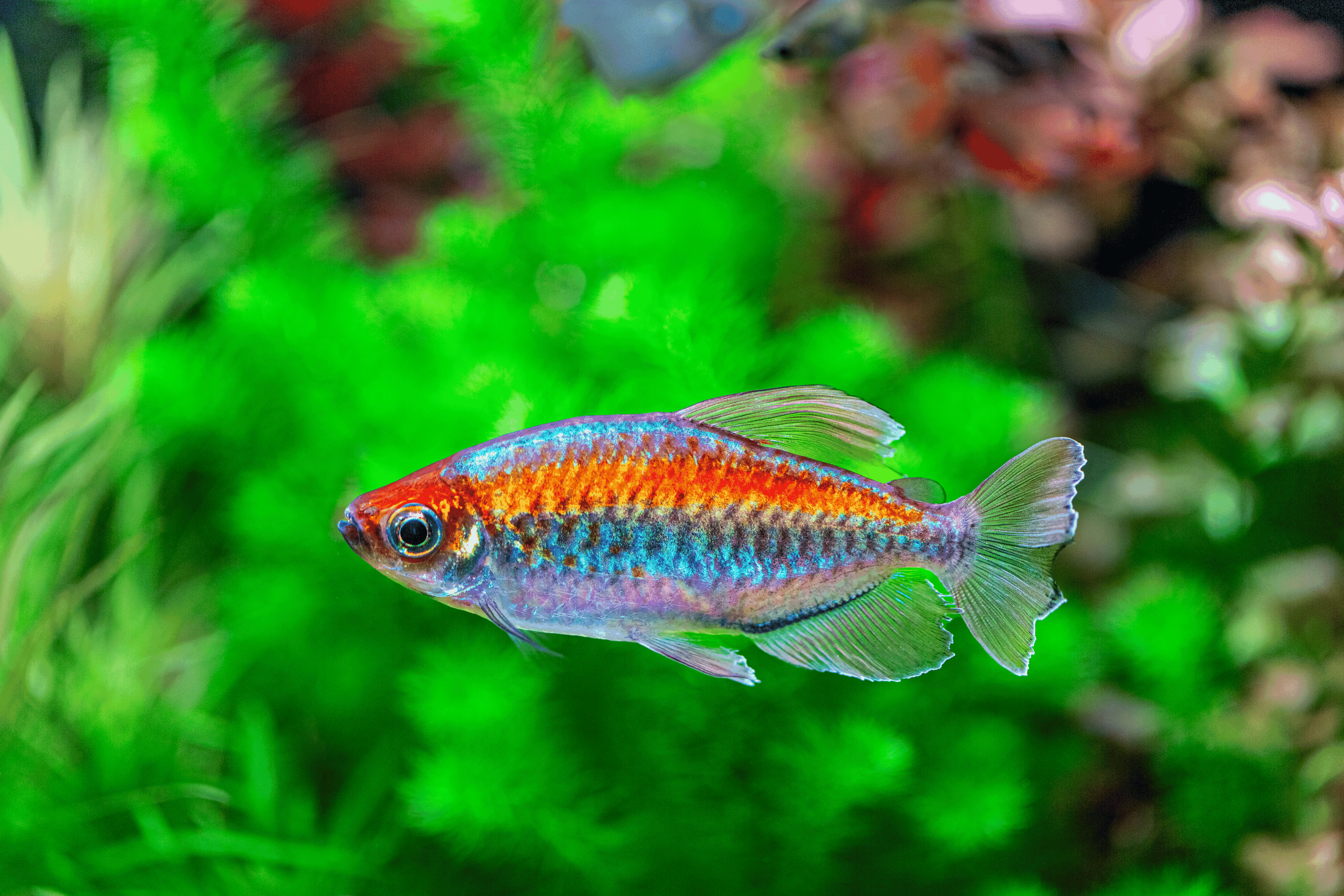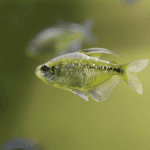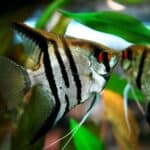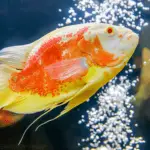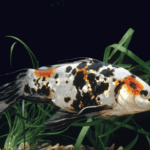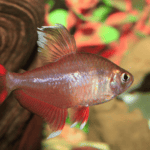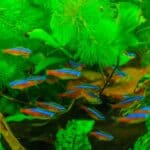The Congo Tetra is a striking freshwater fish that has gained popularity among aquarium enthusiasts for its vibrant colors and ease of care. Native to the Congo River basin in Africa, this schooling fish boasts beautiful shimmering scales and can grow up to 2.5-3.5 inches in length, living for 3-5 years under the right conditions. As a hardy species, it makes for an ideal choice for both beginners and experts looking to add a touch of natural brilliance to their aquariums.
Thriving in slightly acidic water with a pH range between 6.0 and 8.0, the Congo Tetra is often found in murky river waters, surrounded by various aquatic plants. In captivity, they require a tank size of at least 30 gallons to accommodate their need for swimming space and to reduce stress. When kept in groups of six or more, Congo Tetras exhibit a peaceful demeanor, with ideal tankmates including other similarly-sized tetras, rainbowfish, and Corydoras catfish.
As omnivorous fish, Congo Tetras should be provided a balanced diet consisting of both plant-based and protein-rich foods. From frozen or live brine shrimp to flakes and pellets specifically designed for tetras, a varied diet will help ensure these fish maintain their vibrant colors and overall health throughout their lifespan.
Description and Appearance
Size and Body
Congo Tetras are known for their unique appearance, which makes them stand out in any environment. These freshwater fish have relatively long and flat bodies with a tall midsection, giving them a somewhat compressed look. Their large scales contribute to their distinctive appearance. Males are usually slightly larger than females, but females are plumper, particularly when ready for breeding.
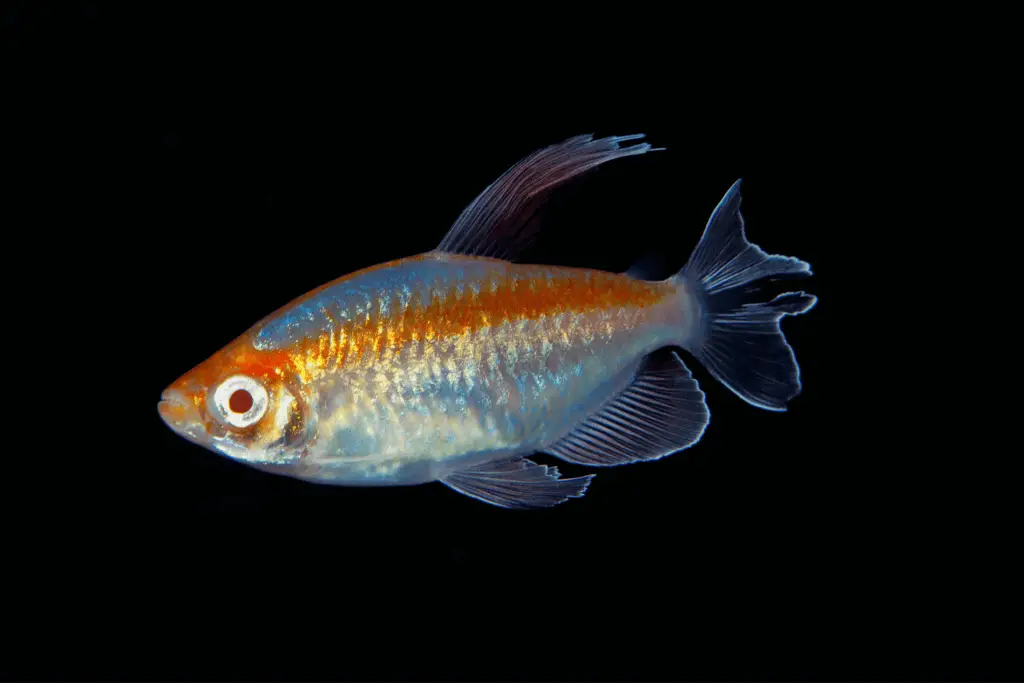
Color and Patterns
The vibrant colors and patterns of Congo Tetras contribute to their popularity in aquariums. Generally, their coloration includes blue on the top, red and gold in the middle, and blue on the belly. The spectacular fins of these fish further enhance their stunning display. Males possess long, flowing fins that are violet with white edging, while their tail fins have an elongated middle section. Females have a more subdued appearance, with shades of gold and silver.
In summary, Congo Tetras are an incredibly eye-catching species, thanks to their unique body shape, large scales, and vibrant coloration. Their appearance becomes even more captivating when considering the differences between males and females and their striking fin patterns.
Habitat and Distribution
Natural Habitat
Congo Tetras (Phenacogrammus interruptus) are freshwater fish found predominantly in the central Congo River Basin in Africa. They thrive in slow-moving waters, such as marshes, peat pools, and streams, which provide a calm and safe environment, given their shy nature. The surrounding vegetation, including live or artificial plants, is crucial for their well-being as it offers plenty of hiding spots, territories, and protection from light. Adding elements such as driftwood, rocks, and caves can also enhance the landscape and provide additional hiding spots.
The water quality is essential for Congo tetras, as they prefer slightly acidic to neutral water with a pH range of 6.0-7.5. The water hardness should be kept between 3-12 dGH, ensuring adequate living conditions for these fish.
Geographical Range
The Congo Tetra can be found in the regions surrounding the Congo River in Africa. However, due to their striking beauty and peaceful demeanor, they have become a popular addition to community aquariums worldwide. Their increased popularity led Florida fish farmers in the 1970s to produce a breeding line, and most specimens available in pet stores today descend from this lineage.
In comparison to other Tetra species, such as Neon Tetras, the Congo Tetra is less common but equally appreciated for their unique appearance, which includes a distinct dorsal fin and a beautifully trailing tail.
Related: Glow With the Flow: All About GloFish Tetras
Diet and Feeding
Feeding in Captivity
Congo tetras are omnivores, making their dietary requirements quite diverse. In captivity, it is vital to maintain a well-rounded diet to ensure the fish’s healthy and active behavior. A mix of dry and live foods is ideal. Dry foods can consist of flakes and omnivore pellets, while live food options include brine shrimp, daphnia, bloodworms, and tubifex worms.
To increase the nutritional value and enhance the overall health of the Congo tetra, it is essential to incorporate a variety of different foods and alternate them regularly. Some aquarists recommend supplementing the fish’s diet with small pieces of fresh vegetables to provide additional vitamins.
Wild Diet
In their natural habitat, Congo tetras consume a wide array of food sources. Their wild diet primarily consists of small invertebrates, such as insects, crustaceans, and other aquatic organisms. Additionally, Congo tetras can be found feeding on plant material like seeds, fruit, and algae.
To replicate their wild diet and maintain Congo tetras’ health in captivity, it is crucial to create a balanced feeding plan that includes both live foods, such as brine shrimp and bloodworms, and dry options like flakes and pellets. This approach allows for a diverse diet that meets the nutritional needs of the species and promotes their well-being in the aquarium environment.
Aquarium Setup and Care
Tank Size and Decorations
Congo tetras require a minimum tank size of 20 gallons for a small school, although a 30-gallon tank is recommended for larger schools. These fish need ample open space in their tank, as they are active swimmers. It is essential to replicate their natural habitat as closely as possible in your home aquarium. Start by adding a layer of substrate, such as fine sand or gravel, to the bottom of the tank. Incorporate driftwood and rocks to create hiding spaces and territories for the tetras.
In addition, add live plants to the aquarium. Java moss and floating plants are ideal choices, as they provide cover for the fish and help to emulate their natural environment.
Water Parameters
Congo tetras thrive in specific water conditions. Maintain the following parameters in your aquarium for their optimum health:
- Water temperature: 72°F to 82°F (aim for 76°F for best results)
- pH levels: 6.0 to 7.5 (preferably closer to the lower end of the range)
- Water hardness: 3 to 18 dGH
Using peat-filtered water can enhance their coloration and overall well-being.
Filtration and Maintenance
Effective filtration is crucial in maintaining the proper water conditions for Congo tetras. Utilize a reliable filter that can handle the bioload from both the fish and plant life in the tank. Regular water changes (about 25% weekly) help maintain water quality, prevent the buildup of ammonia and nitrites, and reduce the risk of illness, such as ich.
Keep an eye on the behavior and health of your fish to ensure that they are thriving in their environment. Congo tetras are peaceful fish with a temperament that makes them easy to care for and suitable tank mates for other non-aggressive fish species. By closely monitoring their health, providing proper water conditions, and maintaining their tank, your Congo tetras will thrive in your home aquarium.
Behavior and Compatibility
Social and Schooling Behavior
Congo Tetras are peaceful and lovely fish known for their social and schooling behavior. They prefer to be in groups and thrive in the company of other tetras. Both males and females exhibit unique body features that distinguish them from each other. Males tend to be larger with more vivid colors, while females are usually duller in color, rounder, and smaller in size. They are active swimmers and enjoy occupying the middle and top levels of the tank, swimming gracefully together.
Congo Tetras can become skittish in the presence of aggression or intense activity from other fish. Consequently, they might spend most of their time hiding. To ensure that your Congo Tetras are comfortable, it is essential to provide them with suitable hiding spots, such as plants and caves, in the aquarium.
Suitable Tank Mates
When it comes to choosing suitable tank mates for your Congo Tetras, keep in mind that they require a peaceful community. Therefore, other non-aggressive fish species would be ideal companions. Some good examples of compatible tank mates are:
- Other Tetras
- Peaceful Cichlids
- Livebearers
- Corydoras
- Rasboras
Avoid pairing Congo Tetras with aggressive fish species, as it can cause stress and affect their well-being. When purchasing fish for your tank, it is advisable to consult with pet stores to ensure compatibility and avoid any potential issues in the aquarium. By maintaining a harmonious environment with suitable tank mates, your Congo Tetras can flourish and showcase their stunning colors and social behavior.
Breeding and Reproduction
Breeding Conditions
To breed Congo Tetras successfully, a 20-gallon breeding tank is recommended. The water should be soft and acidic, with a hardness of 1.5-3 dGH and a pH level ranging from 6.5 to 6.8. Slightly acidic water resembling their natural habitat in the Congo River is ideal. A gradual introduction to peat-filtered water can help replicate these conditions. Providing a stable environment is vital, as Congo Tetras are sensitive to changes in water parameters.
In addition to the above, include live plants such as Java moss or artificial spawning grass in the breeding tank. These serve as a place for the female to deposit her eggs.
Egg-laying
Before attempting to breed, condition the breeding pair of Congo Tetras on live foods for at least a week or two. The male can identify when the female is ready to lay eggs as her body will swell and become darker in color, displaying blue highlights.
During the breeding process, the female Congo Tetra will lay her eggs on the spawning substrate, usually among the live plants or artificial grass. Congo Tetras typically produce a large number of eggs, which makes it essential to provide an adequately-sized breeding tank.
Fry Care
Congo Tetra fry tends to be vulnerable to other tankmates, so it is crucial to separate them from the adults. A second tank with parameters similar to the breeding tank is advisable for this purpose. Ensure that the water is soft and acidic as well, maintaining a stable environment for the fry. As for their diet, provide the fry with high-quality, nutrient-rich foods, including live or frozen foods like brine shrimp.
With proper care, the Congo Tetra fry will progress through various stages of coloration until reaching full maturity. The average lifespan of Congo Tetras is usually around five years.
In summary, successful breeding and reproduction of Congo Tetras depend on providing optimal tank conditions, maintaining water quality, and diligent care for both adult fish and their fry.
Common Health Issues
Diseases
Congo Tetras are generally hardy fish, but they can be susceptible to some common diseases, like ich (also known as white spot disease), which is caused by the parasite Ichthyophthirius. This disease can spread quickly throughout the tank and attack all fish it comes in contact with. Additionally, poor water quality can lead to a weakened immune system, making the fish more prone to other diseases.
Prevention
To maintain the health of your Congo Tetras, it’s essential to ensure optimal water quality. Here are some preventive measures to follow:
- Maintain the appropriate water temperature, as cold water can stress the fish and leave them vulnerable to diseases
- Keep the tank well-filtered and conduct regular water changes
- Utilize a quarantine process when introducing new fish to the tank, as this can help prevent the spread of diseases
- Monitor the behavior of your fish regularly, as changes in behavior may indicate potential health issues
It’s also important to provide ample space for your Congo Tetras and arrange hiding spots, such as caves, to accommodate their large size and make them feel secure.

Treatment
If your Congo Tetras are affected by diseases like ich, it’s essential to act quickly and administer the appropriate treatment. Here are some steps you can take:
- Isolate the infected fish: Remove affected fish from the main tank and place them in a separate, well-filtered quarantine tank.
- Medicate: Treat the fish with medication specifically designed to combat the disease. For ich, antiparasitic medication should be used.
- Increase water temperature: Gradually raise the water temperature in the quarantine tank, as this can help speed up the life cycle of the parasite, making the treatment more effective.
- Monitor the fish closely: Keep a close eye on the progress of the infected fish and ensure that they are responding well to the treatment.
- Treat the main tank: To prevent the spread of the disease, it’s essential to treat the main tank as well. Be cautious with the dosage, as some medications can affect the beneficial bacteria in the tank.
By following this guide, you can better manage health issues in your Congo Tetras and provide them with the best possible care in your aquarium.
Acquiring and Introducing a Congo Tetra
Selecting Healthy Fish
When searching for a Congo Tetra to add to your aquarium, it’s crucial to choose healthy individuals. This beautiful and peaceful fish species originates from the Congo River in Africa and is known by the scientific name Phenacogrammus interruptus. As they are an eye-catching addition to any aquarium, they’re especially suitable for beginner aquarists.
While choosing the fish, ensure they display vibrant colors, have clear eyes, and exhibit an active swimming behavior. Healthy Congo Tetras will have a silver body with a bright orange face and lateral line. Avoid acquiring fish that show signs of stress or disease, such as lethargy, torn fins, or discoloration.
Acclimation Process
Once you’ve selected your healthy Congo Tetras, the next step is to carefully acclimate them to their new environment. The acclimation process is important to reduce stress and ensure a smooth transition for the fish. Follow these steps:
- Water parameters: Ensure the aquarium water is slightly acidic or neutral, with a pH between 6.0 and 7.5. The temperature should be between 73°F and 82°F. If needed, use a heater to achieve the desired temperature.
- Introducing the fish: After confirming that the water parameters are suitable, place the Congo Tetras still in their transport bag into the aquarium. This allows them to become accustomed to the new water temperature.
- Gradual addition of water: Over the course of 20-30 minutes, gradually add small amounts of aquarium water to the transport bag containing the Congo Tetras. This step helps the fish adjust to the water parameters in their new environment.
- Gently release: Finally, use a net to gently transfer the Congo Tetras from the transport bag to their new home. Avoid pouring the water from the transport bag into the aquarium, as it can introduce unwanted contaminants or bacteria.
By following these steps you can successfully introduce healthy Congo Tetras to your aquarium, providing them with an optimal living environment. Remember to carefully monitor water parameters, check for signs of disease, and maintain a peaceful community tank to ensure the long-term well-being of your new aquatic friends.
